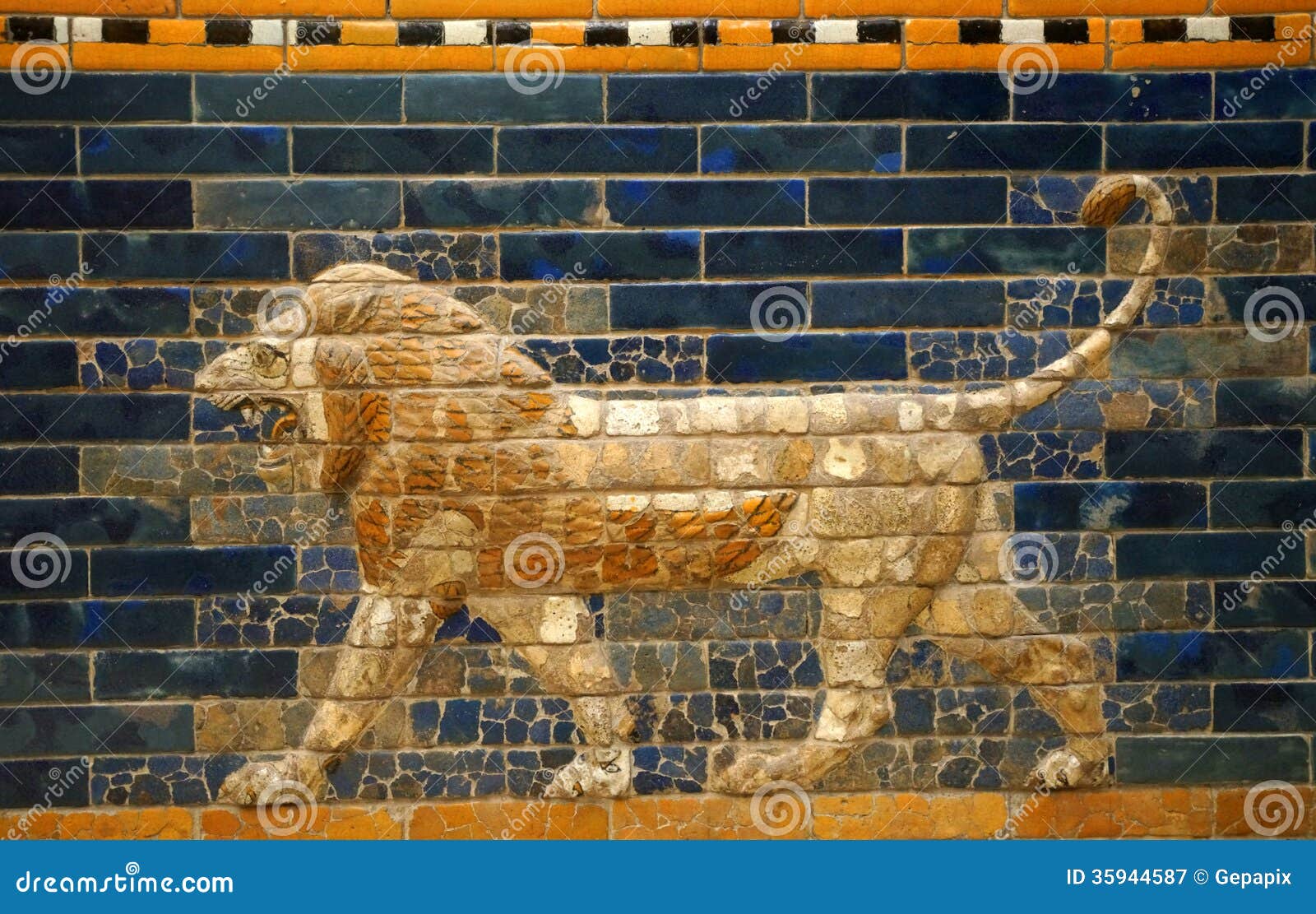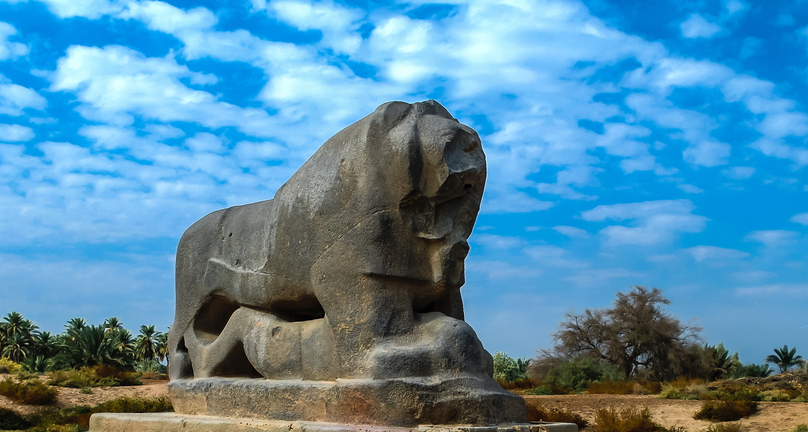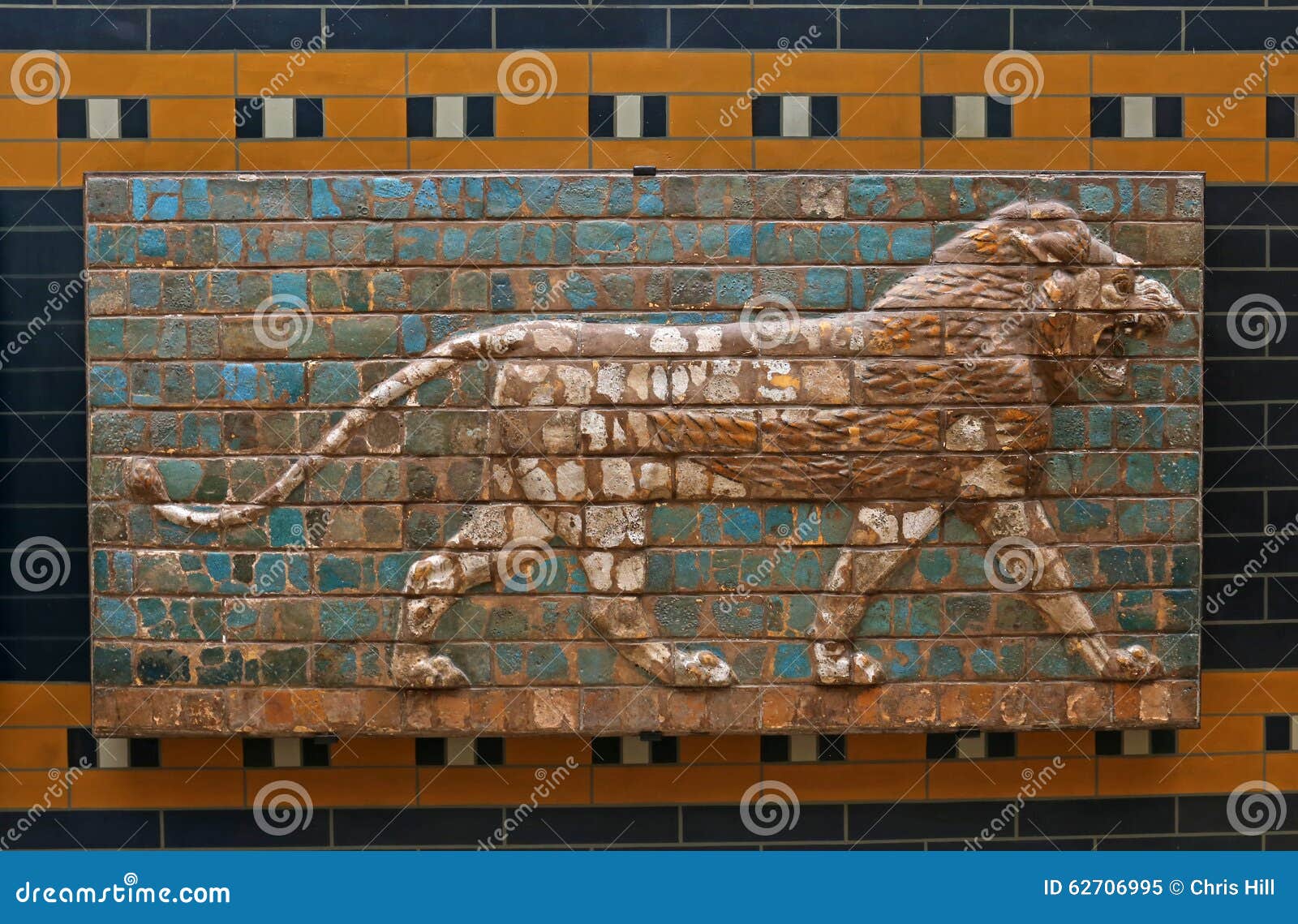The British lion symbolizes the Babylonian Empire of Nebuchadnezzar. Lions are not indigenous to Britannia. The lion symbol was adopted after the Babylonian Captivity, and it represents the kingdom of the Chaldeans. It is beyond belief how such an overtly Biblical symbol should be adopted by a nation which honors evolutionist Charles Darwin. The Lion of Babylon is an ancient Babylonian symbol. The Lion of Babylon symbolically represented the King of Babylon. The depiction is based on the Mesopotamian lion, which used to roam in the region. citation needed The lion featured as the dexter supporter on the coat of arms of Iraq from 1932–1959. citation needed. The Striding Lion of Babylon. The striding lion of Babylon was made of molded brick with polychrome glaze and appeared along the side of the 'Processional Way' in ancient Babylon in 604-562 B.C. The 'Processional Way' led out of the city through the massive Ishtar Gate, the lion was the symbol of the goddess Ishtar. In Assyro-Babylonian ecclesiastical art, the great lion-headed colossi serving as guardians to the temples and palaces seem to symbolise Nergal, just as the bull-headed colossi probably typify Ninurta.
The Striding LionIraq: Babylon, Processional Avenue north of the Ishtar Gate
Neo-Babylonian Period
Reign of Nebuchadnezzar II, ca. 604-562 B.C.
Molded brick with polychrome glaze
90.3 cm H, 230.5 cm W
Purchased in Berlin, 1931
Oriental Institute, Chicago
OIM A7481 This colorful striding lion of glazed brick with its mouth opened in athreatening roar, once decorated a side of the 'Processional Way' in ancient Babylon(the Biblical city of Babel). The 'Processional Way' led out of the city througha massive gate named for the Mesopotamian goddess of love and war, Ishtar,whose symbol was the lion.
Each year, during the celebration of the great New Year Festival, the imagesof the city's deities were carried out through the Ishtar Gate and along the'Processional Way' past some 120 lions and 575 dragons and bulls, in 13 rows, onthe gate, such as this one to a special festival house north of the city. Notall of these reliefs were visible at the same time, however, for the level of thestreet was raised more than once; and originally even the lowest rows, whichwere irregularly laid, may have been treated as foundation deposits. The Iraqantiquities department reconstructed the thoroughfare at one of the higher levels.
The lion symbolizes power and the Babylonians believed that it was Ishtar thatgave them their glory.
Robert Koldewey extensively excavated Nebuchadnezzar’s Babylon beginning in 1899 and the Deutsche Orientgesellschaft. Among thetremendous complex of ruins was the great Ishtar Gate, beautifully decorated witha series of bulls and dragons in enameled, colored brick.
It was Nebuchadnezzar who said,
Babylonian Lion Gate
 'Is this not Babylon the great, which I myself have built as a royal residenceby the might of my power and for the glory of my majesty?'
'Is this not Babylon the great, which I myself have built as a royal residenceby the might of my power and for the glory of my majesty?'Two Striding Lions
Close up of the Striding Lion’s Head
Ancient Babylonia
by R. Russell

2 Kin 24:13-14 'And Nebuchadnezzar of Babylon carried out from there all the treasures of thehouse of the LORD and the treasures of the king's house, and he cut in piecesall the articles of gold which Solomon king of Israel had made in the temple ofthe LORD, as the LORD had said. Also he carried into captivity all Jerusalem: all the captains and all the mighty men of valor, ten thousandcaptives, and all the craftsmen and smiths. None remained except the poorestpeople of the land.'
Also see: Ancient Babylonia Map
Fall ofBabylon Heart Message
Glossary
Introduction
History of Babylonia
Old Babylonian Period(2000 - 1595 BC)
The Amorites,Isin and Larsa,Hammurapi of Babylon,Classical Period,The Language,Religion Law Scienceand the Arts, Babylon,The Kassites, The People of the Sealand,The Hittite Kingdom
Middle Babylonian Period(1595 - 1000 BC)
The Kassite Dynasty,Kadashman-Enlil Iand Burnaburiash II, Kurigalzu II,Elam and Assyria,Dur Kurigalzu a NewCapital, The Kudurru,Nebuchadnezzar I,The Aramaeans,The Culture
Neo Babylonian Period(1000 - 539 BC)
Assyria,Nabu-nasir,Tiglath pileser III,The BabylonianChronicles, The Chaldeans,Sennacherib,Ashurbanipal,Nabopolassar,Nebuchadnezzar II,The Fall of Babylon
Literature
Sumerian Origins,Schools of Scribes,Numbering Tablets,Aramaic and Greek,Poetry, Music,Myths,The Gilgamesh Epic,The Babylonian FloodMyth, Biblical Flood,Prayers and Hymns,Wisdom Literature,Prophecy,Cuneiform
Religion
Marduk and his son Nabu,Babylonian Gods,Temples and Rituals,Priests,Personal Idols,Divination,Astrology,Extispicy,The New Year's Festival,Morality,Prayers and Hymns,Prophecy
Law and Justice
Shamash the Sun God,Civil Law,Law Codes,Hammurapi andRetaliation, Code ofHammurapi Text, Legal Disputes,Labor, Criminal Law, PrisonsSlaves and Women, Legal Documents
King and State
Monarchy,The King's Palace,The King's Harem,Communication,Roads,Scribes,Nebuchadnezzar II
Economy and SocialStructure
Houses and Farms,Irrigation,Artisans,Manufacturing,Trade,Social Hierarchy,Family and Tribe,Domestic Relations,Schools
Science
Scientific Knowledge,Astronomy,The Calendar,Mathematics,Medicine, Nature

Archaeology
Gilgamesh Tablet,The Hammurapi Stele,Ancient Map,Clay Model of a Sheep'sLiver, Mathematics Tablet,Sheeps Liver Cuneiform,Seal Impression,Israelite Seal to Pedaiah,Clay Cylinder ofNabopolassar, The Striding Lion,The Ishtar Gate,The Dragon of Marduk,Nebuchadnezzar's Babylon,The BabylonianChronicles, Basalt BlockInscription, The Ziggurats,Nabonidus Stele,Cyrus Cylinder
Biblical History
David Anoints Solomon,Solomon's Choice,Solomon's Temple,God's Ideal King,The Divided Kingdom,The Northern KingdomIsrael, The SouthernKingdom Judah, Judah'sKings, Hezekiah,The Destruction ofJerusalem, TheBabylonian Captivity, Daniel and the Prophets, Nebuchadnezzar, TheReturn from Babylon

Questions aboutBabylon Answered in the Bible
Maps
Timelines
Lion Of Babylon
© Bible History Online (https://www.bible-history.com)
Related Content
Babylonian Lion Statue
